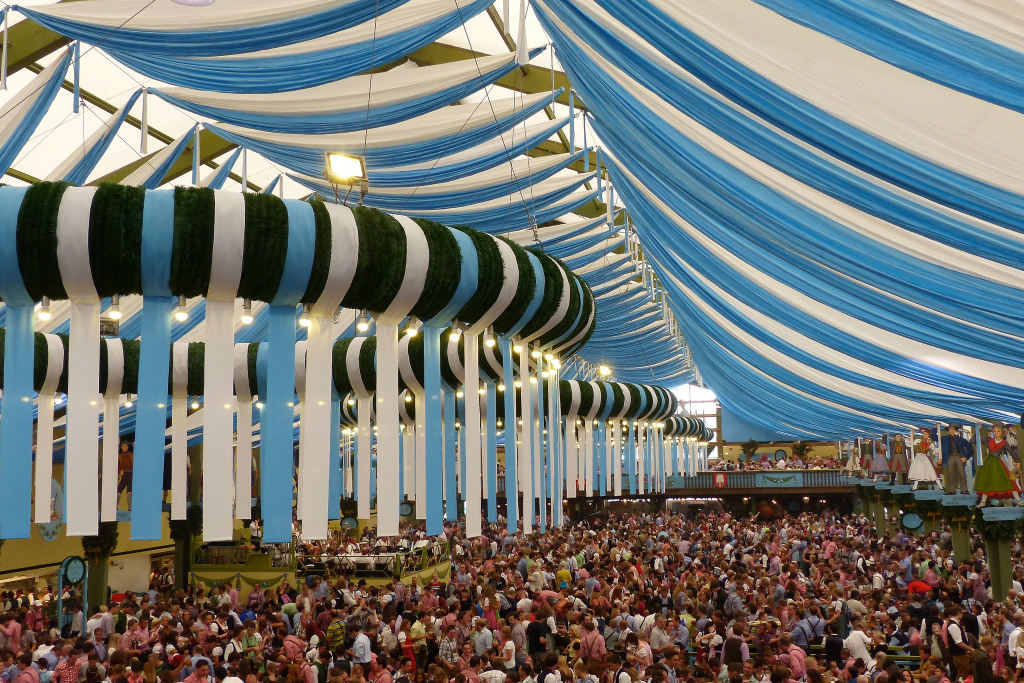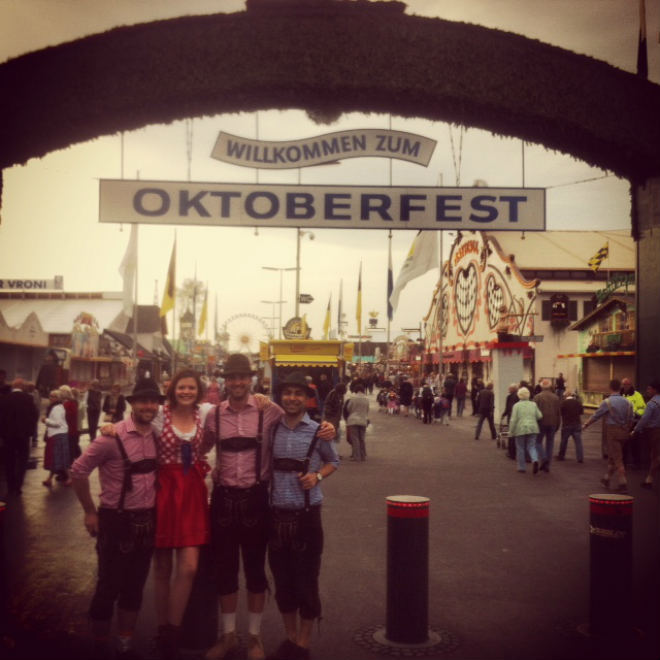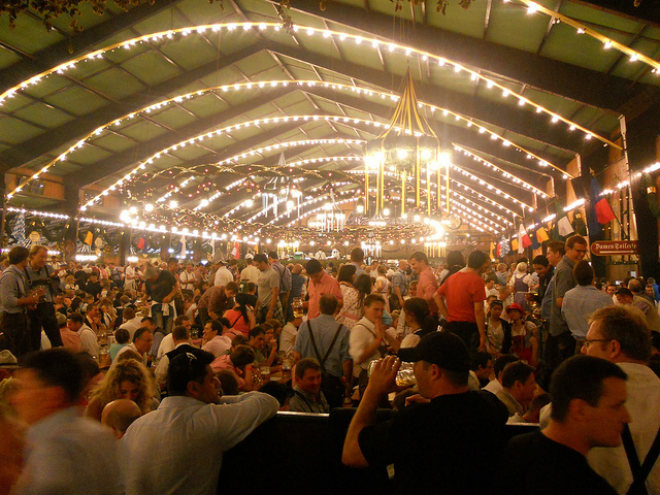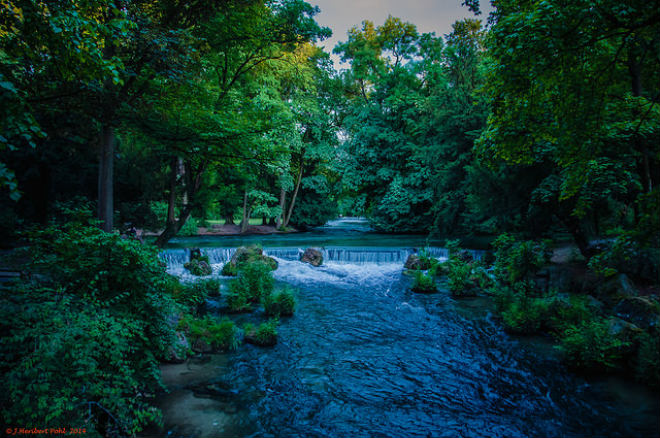Oksoberfest: Going To The World’s Biggest Drinking Festival Totally Sober
It's actually kind of fun not being constantly wasted.


Brought to you by Contiki
Having been to Oktoberfest many times, our friends at Contiki want to show you a different side to the festival.
–
It’s a strange prospect, heading into the world’s biggest celebration of beer with the intention of not drinking any. Normally I’m not much of a morning boozehound anyway, but walking into the festival at 9:30am on a Tuesday I feel weirdly out of place. Red-cheeked groups of young men and women surround me, looking pretty merry already as they sing drinking songs and football club anthems in a variety of languages. They’re sharing huge pretzels, inside jokes and bottles of dark beer.
It’s hard not to feel left out — right up until I step into a lake of still-steaming vomit. Wiping off my leather boot on a patch of grass and watching the passed-out culprit have a dick drawn on his cheek, I feel better about my decision.
Let’s get the obvious bit out of the way: Munich’s Oktoberfest is more than a drinking festival. It’s basically a drinking carnival, surrounding fourteen large brewery tents, each serving a traditional Bavarian beer in huge one-litre glasses called Maß to thousands of people at a time. People come from all over Germany, Europe and the world to drink beer, and drink it in liquid quantities you normally hear when people are talking about swimming pools.
But that doesn’t mean that’s all there is to do in Oktoberfest — far from it. Not drinking at the festival means more room for incredible German food and avoiding the crushing hangovers that can ruin a Munich trip.

–
Inside The Festival, When Everyone Is Drunk But You
Oktoberfest is basically a citywide costume party where everyone’s invited; some people even put their pets in costume. If you don’t kit yourself out in lederhosen or a dirndl you’ll feel pretty silly, or at least a little left out. You can buy a traditional-looking outfit fairly cheaply at the main train station (Hauptbahnhof) and at many stores scattered around central Munich; it’s a pretty great investment because pretty much anyone looks hot in a traditional Bavarian outfit. Each year on the first Sunday of the festival, there’s also a costume parade through the main streets of central Munich. Feel free to join in if you’re eager to show off your new leather pants and feathered cap.
Not drinking like me? Great, all the more room in your stomach for Oktoberfest’s outrageously good food. There are dozens of stalls scattered through the site selling standard carnival fare like donuts, sugar-coated roast nuts, gingerbread, toffee apples, hot chips and fairy floss, but it’s inside the beer tents that the real culinary masterpieces can be found. Every tent has a full-service restaurant where they serve everything from pork knuckles and different styles of sausages to schnitzels and vegetable dishes.
If you get into the festival early (tents open from 10am), you’ll see many Bavarian families settling in to a breakfast of Weisswurst — delicious veal sausages served with sweet mustard and pretzels. But the Germans in the know are here for one thing and one thing only — Hendl. Half a roast chicken, slathered in butter, salt and parsley, and mostly eaten with the hands. No vegetables or side dishes with this bad boy, just melt-in-the-mouth chook. I can attest that it tastes just as good washed down with lemonade and Apfelschorle (sparkling apple juice) as it does with beer.

Image via Jason Paris on a Flickr Creative Commons licence.
Also of note are the speciality oxen dishes served at the Ochsenbraterei beer tent. Go nuts and get the mammoth Ox Platter — it’s not cheap but it’ll feed two people pretty easily. If you have a sweet tooth, try and find the small tent selling Kaiserschmarnn — a fluffy shredded pancake with whipped cream and berry sauce.
If possible, try and be inside a beer tent when the clock hits midday — the house oompah bands all strike up, and even if you aren’t drinking beer it’s pretty great to raise a glass and join in with eight thousand people yelling “Prost!” Get a local to teach you the Bavarian drinking song so you can sing along when the band begins playing it every fifteen minutes for the rest of the day/your life.
Oktoberfest started as a wedding celebration, and the family vibe is still very much in evidence; sure, there are a few British buck’s parties wandering around shouting incoherently at one another, but there’s also heaps of school groups and parents. Do what they do and have a blast on the rides; huge alleys of genuinely excellent roller coasters, pirate ships and giant swings that are (for obvious reasons) actually better to enjoy while sober. This year’s pick was a Munich Olympics-themed roller-coaster that spins screaming punters up, down and around the five gigantic Olympic Rings. Bumper cars and the incredibly lame haunted house are also worth a look.
–
Post-Festival, When Everyone Is Hungover But You
While everyone around you vomits and/or collapses, a true Oksoberfest legend still has energy to party into the night. The Wombats Hostel bar on Senefelderstrasse puts on a great evening from 10pm with pool tables, incredibly cheap drinks (not that it matters, right?) and ’90s music you’re guaranteed to know the words to. Every night there’s an all-night post-Oktoberfest rave at Stiglmaierplatz (mostly drunk Australians and Americans), while smaller bars like Cabane on Theresienstrasse and Jennerwein on Belgraderstrasse are great for more relaxed evenings, sometimes with live music.
Oktoberfest is far from the only attraction in Munich. It’s a beautiful time of year for a stroll or bike ride around the enormous Englischer Garten, which is near the city centre and has a couple of amazing outdoor beer-and-food areas. The Seehaus at the north end of the gardens has the best views for lunch, while the Chinesischer Turm serves excellent ribs and currywurst, often with a traditional Bavarian band playing in the bandstand.
It’s also well worth checking out the surfers who expertly ride a river break at the south end of the gardens, near the National Museum. Further along the riverbank, the Deutsches Museum is a decent option if it’s raining — with a coalmine, a space ship, robots and aircraft, all interactive, it’s kind of like the Powerhouse Museum in Sydney, only better.
Munich is where Hitler and the Nazi party rose to power in the 1920s, and as such the city has a fairly disturbing, extremely compelling history. The Third Reich walking tour is a fascinating way to spend a morning, seeing where a young Adolf Hitler gave his first speeches as well as the few remaining Nazi buildings. I’d also really recommend a trip to Dachau, a town about 20km from Munich where the Nazis set up their first concentration camp. More than forty thousand people were systematically murdered there between 1933 and 1945, so it’s obviously a pretty heavy day out, but also an experience everyone should have.
Further afield, a day trip to Neuschwanstein Castle (which Disney’s ‘Sleeping Beauty’ castle was based on) is fantastic on a clear day. Make sure you walk up to the Marienbrucke to really take in the million-dollar view.
While you’re up there, take a deep breath of the gorgeous mountain air and spare a thought for the thousands of Oktoberfest drinkers who are probably still in bed, nursing their sore heads.
–
With over six million (yep, six MILLION) people attending Oktoberfest each year, organisation and planning takes some doing! Luckily Contiki are the Oktoberfest experts and will take care of all the details so you can focus on keeping your stein filled and your lederhosen up. Check out their range of Oktoberfest and other European festival trips here.
–
Lucy Carter is a radio and television journalist for ABC News. She tweets at@lucethoughts and puns too much.
–
Feature image via Roman Boed on a Flickr Creative Commons licence.

